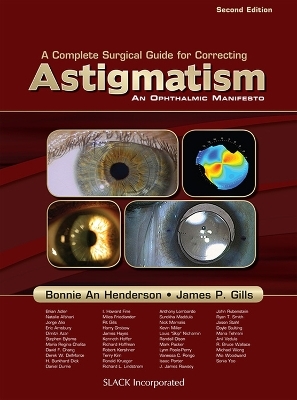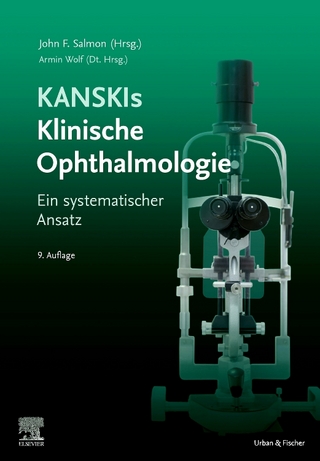
A Complete Surgical Guide for Correcting Astigmatism
SLACK Incorporated (Verlag)
978-1-55642-935-4 (ISBN)
As the fields of cataract surgery and refractive surgery merge, the expectations of patients for perfect postoperative uncorrected vision are increasing. A Complete Surgical Guide for Correcting Astigmatism, Second Edition offers cataract and refractive surgeons a single comprehensive resource on diagnosing and managing corneal astigmatism. Dr. Bonnie An Henderson and Dr. James P. Gills are joined by 45contributors to address all surgical methods of correcting astigmatism, including corneal incisional surgery, laser refractive surgery, and new intraocular lenses. In addition, this Second Edition covers the management of irregular corneal astigmatism and corneal thinning. Sections include:
Preoperative Considerations
Corneal Surgical Correction
Managing Astigmatism in Cataract Surgery
Correcting Astigmatism with Toric Lenses
Managing Irregular Astigmatism
Not only is surgical management addressed in this updated edition, but diagnosis of astigmatism is presented with specific attention to new technology and innovative techniques. Also included are more than 200 color images and 35 tables throughout the pages of A Complete Surgical Guide for Correcting Astigmatism, Second Edition. New topics include:
Diagnosing astigmatism
Approach and timing of surgical correction
Astigmatism by laser keratectomy (PRK, LASIK, LASEK)
IOL calculations with previous refractive surgery
Marking alignment instrumentation
Discussions of innovative techniques and collagen cross linking
New intraocular lenses that are not yet available in the U.S.
A Complete Surgical Guide for Correcting Astigmatism, Second Edition brings together the world’s experts in cataract and refractive surgery, making it a must-have resource for every surgeon aspiring to successfully manage and treat patients with astigmatism.
James P. Gills, MD is founder and director of St. Luke’s Cataract & Laser Institute in Tarpon Springs, FL and Clinical Professor of Ophthalmology at the University of South Florida, Tampa, FL. He is the country’s first ophthalmologist to dedicate his practice solely to the treatment of cataracts via the use of intraocular lens implants. His contributions to medicine span across both academia and clinical ophthalmology. Dr. Gills graduated with honors from Virginia Tech University in Blacksburg, VA and received his medical degree from Duke University Medical Center, Durham, NC, in 1959. He served his ophthalmology residency at Wilmer Ophthalmological Institute of Johns Hopkins University in Baltimore, MD from 1962 to 1965 and was Assistant Professor of Ophthalmology at Duke University Medical Center from 1965 to 1968. He established his academic career early when, as a resident at Johns Hopkins, he published the first scientific paper classifying mucopolysaccharidoses. As his clinical practice grew, he became known by his peers for challenging the status quo, and many ingenious advancements in ophthalmic surgery stem from his drive to improve cataract surgery. Dr. Gills was elected “Best Ophthalmologist in America” by 2 independent groups. More than 30 years ago, he developed an intraocular solution composed of antibiotics and anti-inflammatory medications designed to reduce the risk of infection and inflammation after ophthalmic surgery. This procedure, along with his technique of filtering the irrigating solutions, has probably saved countless eyes and has contributed to St. Luke’s Cataract & Laser Institute’s endophthalmitis rate of 1 in 50,000 cases. Perhaps his most outstanding contribution in ophthalmology was his presentation of the first scientific paper demonstrating the safety and benefit of intraocular anesthesia in 1997. Thanks to this breakthrough, patients undergoing cataract surgery via topical anesthesia can enjoy the procedure free of pain, needles, and patches. Never satisfied unless his patients are independent of glasses, Dr. Gills openly admits to his obsession with correcting astigmatism. His use of limbal and corneal relaxing incisions and placement of more than 17,000 toric intraocular lenses has turned cataract surgery into a refractive procedure. Dr. Gills is known not only for his skills as a doctor, but also for his skill in business as President of a variety of companies, including Past President of the World Triathlon Corporation (Ironman). He is an avid athlete and has competed in 46 marathons, 30 triathlons, 5 Ironman races, 6 Double Irons (the last at 60 years of age), four 200-mile races, and fourteen 100-mile runs. Bonnie An Henderson, MD completed her residency at the Massachusetts Eye and Ear Infirmary of Harvard Medical School in Boston, MA. Her undergraduate and medical degrees are from Dartmouth College in Hanover, NH, where she graduated with high honors. She is currently a partner at the Ophthalmic Consultants of Boston and an Assistant Clinical Professor at Harvard Medical School. Prior to joining Ophthalmic Consultants of Boston, she was the Director of Comprehensive Ophthalmology at the Massachusetts Eye and Ear Infirmary. She serves on the Executive Board of the Massachusetts Society of Eye Physicians and Surgeons and on committees for the American Academy of Ophthalmology and American Society of Cataract and Refractive Surgery. Dr. Henderson is also Founder and President of the Women Ophthalmologists of New England organization. Dr. Henderson is a widely recognized expert in cataract surgery and specializes in complicated anterior segment surgery. Dr. Henderson’s research has involved cataract surgery outcomes and innovative methods of teaching. With the support of a Department of Defense TATRIC grant, she and her co-investigators have developed a novel computer program to teach cataract surgery to trainees. She is also the developer of several medical instruments including a US Food and Drug Administration approved modified capsule tension ring, astigmatism correcting markers, and a capsule polisher. She has published numerous articles in peer-reviewed journals and has delivered over 100 invited lectures nationally and internationally. Her textbook on cataract surgery is one of the most commonly used books in residency programs around the country. Dr Henderson has received “Best of” awards from the American Society of Cataract and Refractive Surgery for her research poster and films and has been awarded an Achievement Award by the American Academy of Ophthalmology as well as the “Teacher of the Year” award from Harvard Medical School. She lives with her husband and 3 children and enjoys competing in triathlons and duathlons.
Dedication
Acknowledgments
About the Editors
Contributing Authors
Preface
Section I. Overview
Chapter 1. Surgical Correction of Astigmatism Bonnie An Henderson, MD; Mana Tehrani, MD; Nick Mamalis, MD; Richard S. Hoffman, MD; I. Howard Fine, MD; H. Burkhard Dick, MD; and Mark Packer, MD, FACSSection II. Preoperative Considerations Chapter 2. Diagnosing Astigmatism Mark Packer, MD, FACS; Natalie A. Afshari, MD, FACS; and Brian D. Alder, MD Chapter 3. Approach to the Surgical Correction of Astigmatism at the Time of Cataract Surgery Eric C. Amesbury, MD and Kevin M. Miller, MDSection III. Corneal Surgical Correction Chapter 4. Correction of Astigmatism by Laser Keratectomy Isaac W. Porter, MD and Dimitri T. Azar, MD Chapter 5. Treating Astigmatism With Conductive Keratoplasty Jason E. Stahl, MD; Daniel S. Durrie, MD; and Ryan T. Smith, MD Chapter 6. Astigmatic Keratotomy: Arcuate and Transverse Incisions for Managing Astigmatism Anthony Lombardo, MD, PhD and Richard L. Lindstrom, MD Chapter 7. Reducing Pre-Existing Astigmatism With Limbal Relaxing Incisions James P. Gills, MD; R. Bruce Wallace III, MD; I. Howard Fine, MD; Miles H. Friedlander, MD, FACS; and Mike S. McFarland, MD Chapter 8. Minimizing Postoperative Cylinder With Peripheral Clear-Corneal Relaxing Incisions Randall J. Olson, MD Chapter 9. Use of Stromal Pockets in the Treatment of Astigmatism Michael Y. Wong, MDSection IV. Managing Astigmatism in Cataract Surgery Chapter 10. Considerations in Clear-Corneal Cataract Surgery Robert M. Kershner, MD, MS, FACS Chapter 11. Management of Astigmatism in Conjunction With Modern Phaco Surgery Louis D. “Skip” Nichamin, MD Chapter 12. Bioptics for the Pseudophakic Patient Louis D. “Skip” Nichamin, MD Chapter 13. Managing Coupling in Secondary Astigmatic Kerototomy James P. Gills, MD; Pit Gills, MD; and J. James Rowsey, MD Chapter 14. Intraocular Lens Power Calculation After Prior Laser Refractive Surgery Kenneth J. Hoffer, MD, FACSSection V. Correcting Astigmatism With Toric Lenses Chapter 15. Toric Intraocular Lenses: History and Applications Surekha Maddula, MD; Harry B. Grabow, MD; Salwa Abdel-Aziz, MD, MPH; and Nick Mamalis, MD Chapter 16. The STAAR Toric Intraocular Lens: Indications and Pearls Stephen Bylsma, MD and David F. Chang, MD Chapter 17. The Use of AcrySof and ReSTOR Toric Intraocular Lenses in the Management of Astigmatism Derek W. DelMonte, MD and Terry Kim, MD Chapter 18. Repositioning Toric Intraocular Lenses David F. Chang, MD Chapter 19. Other Toric Intraocular Lenses Vanessa C. Pongo, MD and Jorge L. Alió, MD, PhD Chapter 20. Correction of Astigmatism With Toric Intraocular Lenses: Correct Marking and Alignment Jonathan B. Rubenstein, MD Chapter 21. Correcting High Degrees of Astigmatism Lynn J. Poole-Perry, MD, PhD and Bonnie An Henderson, MDSection VI. Managing Irregular Astigmatism Chapter 22. Correction of Irregular Astigmatism Maria Regina Chalita, MD and Ronald R. Krueger, MD, MSE Chapter 23. Diagnosis and Management of Traditional Penetrating Corneal Transplant Astigmatism James C. Hays, MD Chapter 24. Reducing Post-Graft Astigmatism Miles H. Friedlander, MD, FACS Chapter 25. Treatment of Keratoconus Maria A. Woodward, MD and R. Doyle Stulting, MD, PhD Chapter 26. Treatment of Keratoconus: Astigmatic Keratotomy and Intraocular Lenses J. James Rowsey, MD; James P. Gills, MD; and Pit Gills, MD Chapter 27. Astigmatism Management of Peripheral Corneal Thinning Anil Vedula, MD and Sonia H. Yoo, MD Financial DisclosuresIndex
| Erscheint lt. Verlag | 30.10.2010 |
|---|---|
| Sprache | englisch |
| Maße | 216 x 279 mm |
| Themenwelt | Medizin / Pharmazie ► Medizinische Fachgebiete ► Augenheilkunde |
| Medizin / Pharmazie ► Medizinische Fachgebiete ► Chirurgie | |
| ISBN-10 | 1-55642-935-5 / 1556429355 |
| ISBN-13 | 978-1-55642-935-4 / 9781556429354 |
| Zustand | Neuware |
| Haben Sie eine Frage zum Produkt? |
aus dem Bereich


